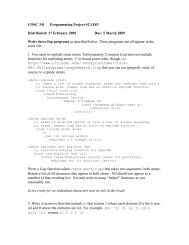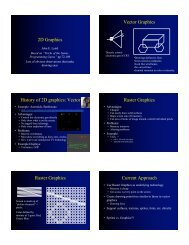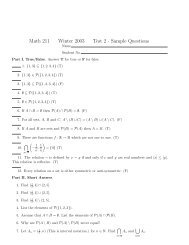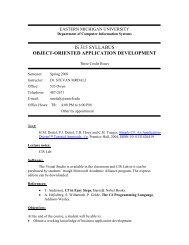Notes on Recursive FFT (Fast Fourier Transform) algorithm Fall ...
Notes on Recursive FFT (Fast Fourier Transform) algorithm Fall ...
Notes on Recursive FFT (Fast Fourier Transform) algorithm Fall ...
Create successful ePaper yourself
Turn your PDF publications into a flip-book with our unique Google optimized e-Paper software.
<str<strong>on</strong>g>Notes</str<strong>on</strong>g> <strong>on</strong> <strong>Recursive</strong> <strong>FFT</strong> (<strong>Fast</strong> <strong>Fourier</strong> <strong>Transform</strong>) <strong>algorithm</strong><br />
<strong>Fall</strong> 2010, COSC 511<br />
Susan Haynes<br />
(1) The <strong>Fourier</strong> <strong>Transform</strong> transforms a (|a| = n) vector in spatial or time domain to a vector in<br />
frequency domain.<br />
(2) The <strong>Fourier</strong> <strong>Transform</strong> is invertible.<br />
(3) C<strong>on</strong>voluti<strong>on</strong> (e.g., polynomial multiplicati<strong>on</strong>) is O(n 2 ).<br />
(4) C<strong>on</strong>voluti<strong>on</strong> in spatial domain is the same as pair-wise multiplicati<strong>on</strong> in the frequency domain.<br />
(5) <strong>Fourier</strong> transform of a vector a can be performed by a matrix - vector multiply, where the matrix<br />
encodes the <strong>Fourier</strong> transform and the vector is a. Matrix - vector multiply is O(n 2 ).<br />
(6) The <strong>FFT</strong> uses a particular matrix, F, where each element is <strong>on</strong>e of the n-th roots of 1 (unity). The<br />
element of the matrix at row i, column j (starting at (0,0) ) is ω n i*j . To compute <strong>FFT</strong>(a) using the matrix<br />
F and vector a is O(n 2 ) (see comment 5). <strong>FFT</strong> -1 element at (i, j) is (1/n) ω n<br />
-i*j<br />
(7) ω i n has some nice properties:<br />
• ω i n * ω j n computes to <strong>on</strong>e of the n complex n-th roots.<br />
• ω i%n i<br />
n = ω n<br />
i<br />
adding any multiple of n to the exp<strong>on</strong>ent, gives the original ω n )<br />
• ω dk dn = ω k n (e.g., ω 6 8 = ω 3 4 ) AKA cancellati<strong>on</strong> property<br />
• If n = 0 is even, then the squares of the n nth-roots of unity are the n/2 complex (n/2)-th roots of<br />
unity. E.g., C<strong>on</strong>sider the 4 fourth roots of unity: ω 1 4 , ω 2 4 , ω 3 4 , ω 4 4 . Square them: ω 2 4 , ω 4 4 , ω 6 4 ,<br />
ω 8 4 . By the previous cancellati<strong>on</strong> property. The squared roots are ω 1 2 , ω 2 2 , ω 3 2 , ω 4 2 . By the mod<br />
property, those squared roots are ω 1 2 , ω 0 2 , ω 1 2 , ω 0<br />
2 which are exactly the two 2 nd roots of unity.<br />
(8) The <strong>FFT</strong> can be implemented as a divide-and-c<strong>on</strong>quer (hence a recursive) <strong>algorithm</strong>, giving O(n lg n).<br />
The analysis is similar to the analysis for merge-sort.<br />
(9) C<strong>on</strong>voluti<strong>on</strong> p1 ⊗ p2 = q, using <strong>FFT</strong> is O(n lg n) (rather than O(n 2 ), see comment 3) because:<br />
P1 = <strong>FFT</strong>(p1) is O(n lg n)<br />
P2 = <strong>FFT</strong>(p2) is O(n lg n)<br />
Q = P1 * P2 (pairwise) is O(n)<br />
q = <strong>FFT</strong> -1 (Q) is O(n lg n)<br />
1 <strong>Fall</strong> 2010
(10) The pseudocode for <strong>FFT</strong> (recursive versi<strong>on</strong>) from Cormen, Leissers<strong>on</strong>, et al, is:<br />
<strong>FFT</strong> (a) { // 1D array a = (a 0 , a 1 , … , a n-1 )<br />
1 n = length (a) // n is a power of 2<br />
2. if (n == 1)<br />
3. return a<br />
4. ω n = e 2πi/n 1<br />
// ω n<br />
5. ω = 1<br />
6. a [0] = (a 0 , a 2 , a 4 , … a n-2 )<br />
7. a [1] = (a 1 , a 3 , a 5 , … a n-1 )<br />
8. y [0] = <strong>FFT</strong>(a [0] )<br />
9. y [1] = <strong>FFT</strong>(a [1] )<br />
10. for (k=0; k
3 <strong>Fall</strong> 2010
4 <strong>Fall</strong> 2010
5 <strong>Fall</strong> 2010











